
Water | Resources
Beyond Toxic-Free Industrial Products

I spend a lot of my time (as you know) working on finding and writing about toxic-free, manufactured industrial products because that’s where most people shop.
But for many years now, I’ve actually been living this “other” life that is beyond industrial products. It’s the next level of living toxic-free. Much more difficult and not available everywhere, but oh so rewarding.
I actually started envisioning living this way in 1987 but gave up because I couldn’t find it. But now thirty years later…
Here’s how I spent last Sunday
I spent most of my day going to our local “farm market” (that’s what they call it here, not “farmer’s market”) and also our annual Gravenstein Apple Fair, which celebrates the harvest of the Gravenstein Apples, unique to our area.
Both of these experiences made me very happy I live here as they take my experience of toxic-free living well beyond the action of choosing products without chemicals from store shelves. They take me back to LIFE.
THE CHANGING OF THE SEASON AT THE FARM MARKET
About 30 years ago I began to study nature, and one thing I learned was about the changing of the seasons. On our civil calendar “The First Day of Autumn” has been fixed September 21, but it’s not. The Autumn Equinox that falls on that day is the middle of autumn.
I had an ancient calendar that marked a date in early August as the end of summer and the beginning of autumn and there was a festival to celebrate it. That this time of year was the end of summer and the beginning of autumn was kind of theoretical to me because it is always hot in August wherever I’ve lived, but I could see small indicators.
I’ve now been going to the farmer’s market every Sunday for almost a year, and this week, I really saw that ‘autumn is a comin’ in’. The Gravenstein apples are here, as well as Gravenstein cider and a tent telling you where you can use the community apple press to press your apples for juice. The multicolored cherry tomatoes are gone. My farmer who has been providing gorgeous cherry tomatoes and bell peppers and Persian cucumbers said good-bye to me this week. He won’t be back until January. The entire spectrum of foods in the fields is changing.
While tomatoes are ending, cauliflower is just beginning. I can’t resist these baby cauliflowers. So tender and sweet.

We don’t see this change of season in the supermarket. But it’s very real at my farmer’s market and on my plate.
We’re moving into the time of harvest. I’m working hard now to bring in the “harvest” of the work I’ve been doing all year to move my work to the next level with a new website. I can start to see the new website now. Structure is up. I’m starting to organize data. I’ve found someone to help me with the technical challenges and we were started work on that yesterday. I’m working full speed ahead.
Eating seasonal, local, organic food is part of my “practice” of living toxic-free. It goes beyond reading labels to avoid toxic chemicals in industrial products, to the next level of aligning with life itself.
For the past two weeks we’ve been sampling different varieties of peaches. We’ve been putting each variety in separate bags with their names on them to get to know them. The farmer explained how the best peaches were the first peaches picked from the outside of the tree where they get the most sun and that the following week that week’s varieties would be coming from the inner branches and new varieties would be being picked from the outside of other trees.
Imaging my surprise when I brought these peaches home and cut them open and there was a sunset of colors inside the peach! Not just white or orange, but white and orange and deep red and purple. I though I would pull a photo off the internet with these colors and couldn’t find one. But this week we bought a whole entire box of peaches, and as I was peeling peach-after-peach I discovered the deep turn of color comes from ripeness. I had just never before eaten a peach that was actually ripe. But it’s only ripe like this for moments. The next day they begin to rot.

AND THEN WE WENT TO THE GRAVENSTEIN APPLE FAIR
This was the first time I’ve been to this particular fair and it moved me deeply.
First, it was a city fair, so it wasn’t at a fairgrounds, it was in a park, under oak trees. There were local craftspeople, food tents set up by local restaurants and children showing and explaining their 4H animals, and bands providing music. The entire fair was the city in microcosm. And Gravenstein apples—apple pie baked by the ladies of a local Church who bake the pies every years, apple fritters, apple cider, boxes of apples, bags of apples—all Gravenstein everything. One food stall offered a grilled cheese sandwich made with slices of Gravenstein apple, local blue cheese and local honey. Apples, apples, apples!
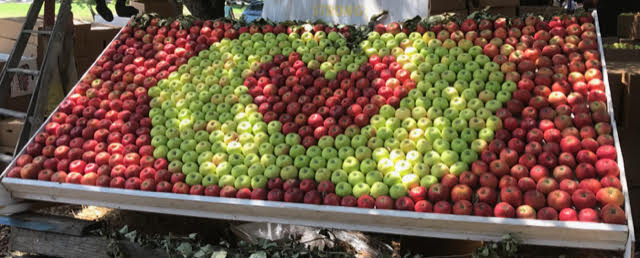
Of course, Larry and I walked in an immediately bought a piece of pie to share. I looked up and everyone around me was eating pie made with our local apples, baked with the loving hands of our local women, and tears came to my eyes. This is what creates community. Once of the reasons I left Florida was because I was once told not to bring homemade food for refreshments to a meeting—only packaged foods. Sitting under the oak trees eating apple pie with my community made me feel part of the community, not only in the moment, but part of it’s history past and future.

I had to include this photo above of the disposal area. It’s more that trash and recycling. It was landfill, recycling, compost, and pig food.
But of course. This is a farming community. And so our fair had woodcarving and historic farm equipment and “agrarian games” (I didn’t see those, but I’m thinking they may be like the Scottish Highland games, which are competitions of skill based on things actually done in local work life).
Here the food is seasonal, local, and organic with full disclosure. You can’t buy Mindful Meats online. They are local. And you can call up all these farms on this chalkboard and they will proudly tell you all about how they grow and raise their food. No secrets here.
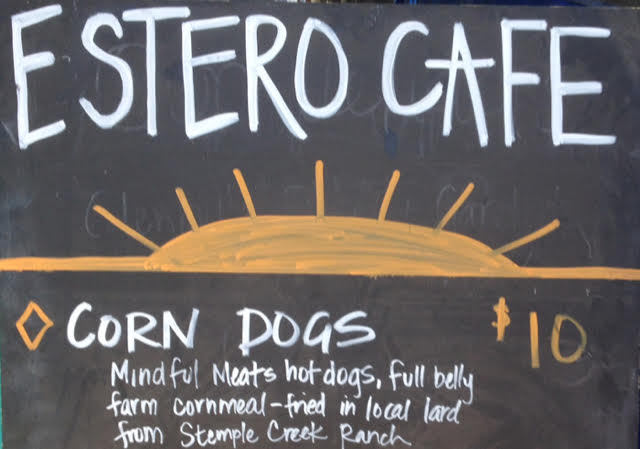
This is how life should be!!!!! Everywhere.
Enough. I think you get the idea. I feel like I’ve come home.
As we were walking to our car I said to Larry, “This fair is in agreement with me. It’s just how I would design it. And I am in agreement with it. This is where we belong.”
And he agreed.
Safe Pesticide for Spiders?

Question from Michelle
Hi Debra,
I ask this question in the light that we are fighting brain cancer. We are also fighting spiders.
We have done everything possible around the house-changing lighting cans, switch plates, stuffing windows with molding, diatomaceous earth and we are still getting spiders.
I called Ecola and although they pushed their standard pesticide which we will never use, they also mention a “green version” made with “essential oils.”
I asked for the ingredients and they are as follows: thyme oil 20%, 2-phenethyl propionate 14%, rosemary oil 8 % and a combo of polyglyceryl oleate, isopropyl alcohol, wintergreen oil, and isopropyl myristate 58%.
Do you consider this a safe, non-toxic alternative? Thank you very much for your advice and help.
Debra’s Answer
First I want to just be clear that I can’t tell you if any product is “safe” for you.
I can tell you if it contains ingredients that are known to be toxic.
But there is a difference between the ability of a substance to cause harm and whether or not it will cause harm FOR YOU. Many factors about your body can affect how sensitive or tolerant you are to a substance or how well you r body can withstand whatever danger may be present.
That said, here’s what I can tell you about these materials.
Thyme oil, rosemary oil and wintergreen oil are essential oils. They are concentrated oils from plant sources. Some people who are sensitive to these oils react to them, but they are not toxic, per se.
2-phenethyl propionate is a natural substance found in peanuts. It is considered a “low risk pesticide” in the US and can be used here without registration. It is commonly used in natural pesticide products.
Polyglyceryl oleate is not considered be toxic or harmful.
Isopropyl alcohol is rubbing alcohol. It is generally made from petroleum when used as an ingredient. It is not expected to be toxic or harmful.
isopropyl myristate is composed of of isopropyl alcohol and myristic acid, a common, naturally occurring fatty acid. It is not expected to be toxic or harmful.
Based on this information, I would say this is likely to not be harmful. It does not, for example, contain known carcinogens.
It’s about as “not harmful” as a pesticide can be, That said, your body may not tolerate this and other products in ways not accounted for by toxicology.
If I needed a pesticide for spiders, I would use this.
Health Effects of Gas Stoves
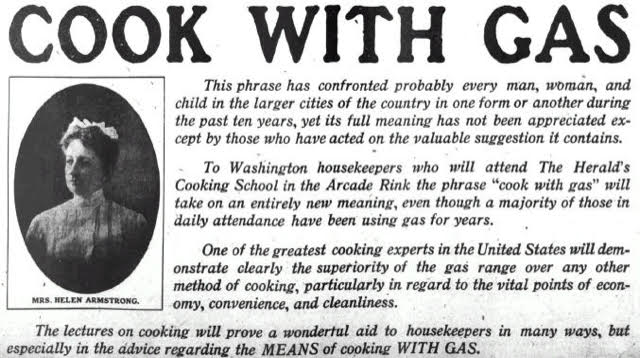
I saw a blog on Treehugger that environmental engineering professor Shelly L Miller tweeted a whole rush of scientific papers on the health effects of air emissions from gas stoves, so I had to run right over to her Twitter page and get them for you. Imagine my surprise when I arrived on her page and Twitter said Shelly “follows you.”
As a home cook I am a fan of using gas over electric, and thought I was doing OK because I kept my stove well-adjusted. But when I started checking my indoor air with a real-time monitor, the VOCs spiked every time I cooked something on the stove.
Now here’s the scientific data about how that’s harmful to health.
BTW, I’m no longer cooking with gas. I either use my induction burner in my tiny kitchen or my mother-in-law’s electric stove.
NOTE some of these links are unclear, but I’ve just put everything here as I found it. I’ll continue to add to this list and feel free to add studies you find in the comments.
From Shelly Miller’s:
Induction stoves a great option for consumers to move towards a fossil-fuel free home, plus it eliminates a huge source of pollution (NO2, CO, particles) in the home. #healthyhome #indoorairpollution
7 Aug 2018
Get ready, I’ll be posting a bunch of references/studies on the association between adverse respiratory health and gas stoves #sciencetwitter #indoorairpollution #healthyhomes
8:46 AM – 8 Aug 2018
From the #SixCities study: strong evidence for causal effect of 2ndhand smoke on increased respiratory illness and exposure to gas stoves associated with reduced pulmonary function – all in children. https://www.atsjournals.org/doi/pdf/10.1164/arrd.1984.129.3.366 …
8:51 AM – 8 Aug 2018
Respiratory symptoms were more common in children exposed to a gas stove. “Respiratory Symptoms in Children and Indoor Exposure to Nitrogen Dioxide and Gas Stoves” | American Journal of Respiratory and Critical Care Medicine https://www.atsjournals.org/doi/abs/10.1164/ajrccm.158.3.9701084 …
8:53 AM – 8 Aug 2018
Women who used gas for cooking had increased risk of asthma-like symptoms and had reduced lung function and increased airways obstruction compared to those who did not use gas https://www.sciencedirect.com/science/article/pii/S0140673696900094 …
8:56 M – 8 Aug 2018
Children from households with gas stoves had a greater history of respiratory illness before age 2 and small but significantly lower levels of FEV1 and FVC corrected for height https://www.atsjournals.org/doi/abs/10.1164/arrd.1980.121.1.3 …
9:02 AM – 8 Aug 2018
#openaccess and shows the impact of using ventilation while cooking Shelly L Miller added,
9:05 AM – 8 Aug 2018
In homes using gas stoves, children whose parents reported using ventilation when using the stove had higher lung function and lower odds of asthma, wheeze, bronchitis compared to homes that never used ventilation or did not have ventilation available
9:05 AM – 8 Aug 2018
OK thats enough on gas stoves & respiratory health for now. Over 25 years ago when I was a PhD student at Berkeley talking to an EPA scientist about the most important #indoorairquality issue, and he said: gas stoves, because the association with adverse health is clear.
9:16 AM – 8 Aug 2018
And yet another study showing CO2 levels in offices above 1000 ppm causes lower cognitive functioning. Great study @j_g_allen Shelly L Miller added,
9:17 PM – 9 Aug 2018
Window Air Conditioner Without Odor?

Question from Bonnie
Hi Debra,
I have owned Kenmore window ac over the years – no chemical odors.
I have a new one and now is 3 months old – still has the new smell chemical.
Could you post to ask others if they found one that has less odor. Thank you.
Debra’s Answer
OK posted. Readers, any recommendations for a window air conditioning unit that doesn’t smell like plastic?
Cloth-covered Ethernet Cable

This cloth-covered ethernet cable is available online.
Question from Lindsey
Hi Debra,
Can you tell me if you know of a lead-free Ethernet cable? There are cloth-covered extension can red (links found on your site) & cloth-covered USB but I can’t find any Ethernet cables. Thank you!
Debra’s Answer
Here’s one: Vandesail Cat7 Ethernet Cable, Cat 7 RJ45 LAN Network Cable, High Speed Durable Nylon Braid STP.
It’s nylon. Not perfect, but no lead. 🙂
Also here is a “cable sash” you can use to cover PVC cables or bundle cables together. And another cable sleeve with a zipper. Both nylon.
I have been known to wrap cords with wired floral ribbon, which comes in pretty colors. The wire in the ribbon helps it stay in place.
Car Floor Mats Exposure
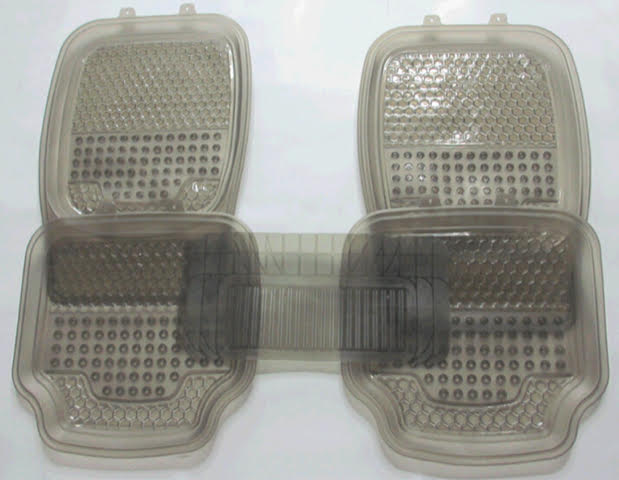
Question from Catherine
Hi Debra,
I just arrived in California to attend a weddinga nd my sister lent us a truck she has used in her business, so it’sa little rough.
My husband drove my two young daughters to the beach and hiking in it. I finally jumped in it when I was hit with a strong PVC (I think that was what is is) chemical odor and could smell it coming from the plastic floor mats. I had no idea that such toxic mats were in the vehicle, and to know my two kids were being driven in it for hours over a few days. I was so upset. The mats are apparently years old and no one else seemed bothered by them but me, butt hey smelled so strong I was hit with the odor when the door was opened.
My first question is are my children in danger from their exposure? Do I need to clean their shoes etc?
And how do you handle family who think your concerns are silly or when they don’t take your concerns seriously?
Debra’s Answer
I also don’t like the smell of floor mats, but let’s take a look at what they are actually made from before we figure out the danger.
Here’s a couple of paragraphs from an article about materials used to make floor mats and liners.
What are the all-weather floor mats and liners made of?
In order to withstand punishing year-round weather conditions and serious spills, the all-weather floor mats and liners are made from durable materials. Most of the all-weather floor mats are crafted from heavy-duty rubber, which can survive serious abuses virtually unscathed. However, the lighter-duty Catch-All Floor Mats use a thick weave of nylon rather than rubber, but they can still be washed off with a hose.
Floor liners are also made from ultra-durable materials, many of which are proprietary fabrications by the different companies. For example, Husky Liners developed a rubberized-plastic material called polydurathene, which is guaranteed not to crack, splinter or break for 99 years. What’s more, the scientists at Xtreme created Xynet, a resin with the look and flexibility of rubber. Xynet is impervious to the most common chemicals found in and around your vehicle, such as motor oil, gasoline and even battery acid.
That said, I searched specifically for “PVC auto floor mats” and they came right up.
So let’s assume they are PVC.
I’m not worried about your children having this one exposure. The problem is being exposed to these chemicals day-in-and-day out. I would be much more concerned if you told me your children were sleeping every night on a crib mattress with a vinyl cover.
Cleaning their shoes won’t do much by now.
How do you handle your family? All I know to do is education. I’m actually working on putting together some materials that I hope will be more convincing for people who are not yet aware that they need to be concerned about toxics.
I don’t have floor mats in my car. If you think you need them, those made from nylon would be the least toxic. Or I might cut some natural sisal mats to fit.
Readers, any recommendations?
How to clean wood kitchen cabinets?

Question from Colleen
Hi Debra,
I have original Scheirich wood kitchen cabinets in our kitchen. How do I go about cleaning and fixing water damage on the front of the cabinets below the sink and cleaning grease and greasy fingerprints off them. I don’t know what type of finish is on them. Can anyone help? I have MCS and anything with fragrance cause migraines and breathing problems. Thank you!
Debra’s Answer
The first thing I would do is contact the manufacturer to find out the standard care instructions and then figure out how to do the same thing in a nontoxic way. But looking online it seems like this brand is no longer being sold.
Here’s a whole pinterest page about “restoring mid-century wood cabinets”.
I had to smile when I saw this.
I grew up in a mid-century suburban house. My parents bought it in 1962 when I was 7 years old for $19,000. Now those homes are about $500,000.
Here’s an article about cleaning kitchen cabinets using Murphy Soap.
However, Murphy Soap contains fragrance. I see you can substitute unscented liquid castile soap for Murphy’s Soap.
Maybe my friend Gina will jump in and tell us how she cleans wood cabinets. She’s been a professional natural cleaner for as long as I have been writing about toxic-free products. Gina!!! Come help!!!
JUST AN ASIDE: While I was researching this I came across an EWG review of Murphy’s Oil Soap. Fragrance is NOT listed on their list of known ingredients (though it does say citronella oil) and it says “ingredient disclosure: poor” All they need to do is go to the Murphy’s Oil Soap website to find out there is fragrance. This is just one example of why I do my own research and don’t rely on EWG.
Be Prepared to Purify Your Indoor Air in a Crisis
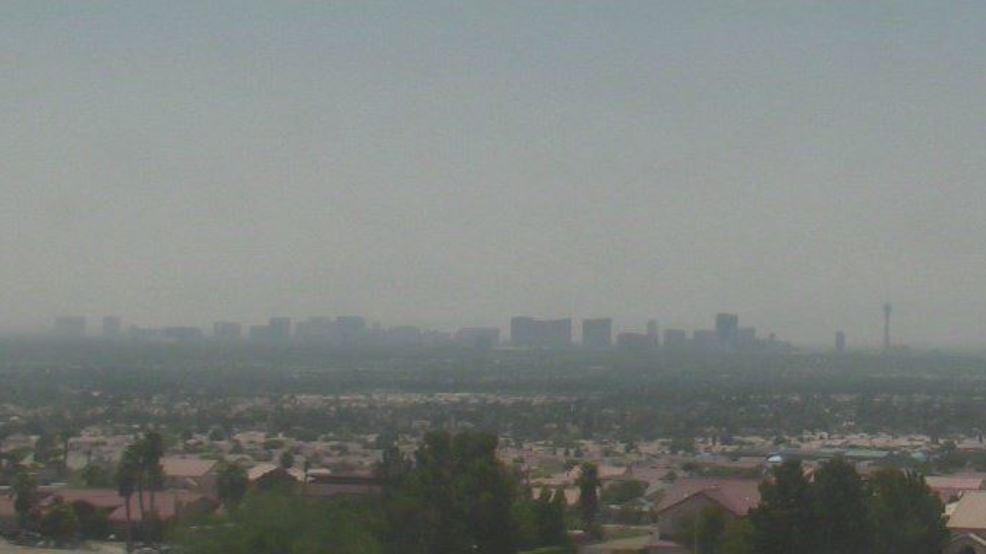
A view from the east bench taken about 1 p.m. Sunday, Aug. 5, 2018, shows ozone-heavy skies in the Las Vegas valley. (Kevin Janison | KSNV)
One of my most favorite readers sent me an article last week about air filters—one of those 10 tips articles that someone writes who doesn’t know anything about the subject. She thought I should write something on this topic, so here I am.
I agree that during a crisis—whether it be a fire, nuclear attack,or any calamity—outdoor air could be compromised. And last summer I had that experience first hand when I was mere miles from the Sonoma County Firestorm. I had to leave my home in the middle of the night and go to the beach to breathe, just a few nights after I arrived in California.
And now here we are in fire season again in California. At the moment we are fine. But you never know when there will be smoke or where it will go.
The photo above was taken Sunday afternoon in Las Vegas—445 miles as the crow flies.
When the smoke arrives, it’s too late to get an air filter.
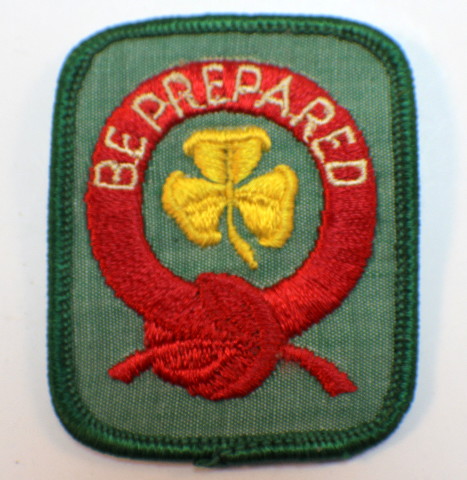 I was a Girl Scout when I was younger. And the Girl Scout motto is “Be Prepared.” The idea is, obviously, if you learn what to do in life or in an emergency before it happens, you’ll suffer less, or you may not suffer at all.
I was a Girl Scout when I was younger. And the Girl Scout motto is “Be Prepared.” The idea is, obviously, if you learn what to do in life or in an emergency before it happens, you’ll suffer less, or you may not suffer at all.
Air filtration is just one of those things you just need to be prepared for.
And you only have seconds to get air filtration going when you need it most:
- Between 30-180 seconds of oxygen deprivation, you may lose consciousness.
- At the one-minute mark, brain cells begin dying.
- At three minutes, neurons suffer more extensive damage, and lasting brain damage becomes more likely.
- At five minutes, death becomes imminent.
- At 10 minutes, even if the brain remains alive, a coma and lasting brain damage are almost inevitable.
- At 15 minutes, survival becomes nearly impossible.
AIR IS THE MOST ESSENTIAL THING TO LIFE
Q&A: The Greatest Danger to Firefighters Isn’t the Fire—It’s Cancer from Toxic Smoke
Plastic-Free, Silicone-Free or Latex-Free Braces Or Retainer
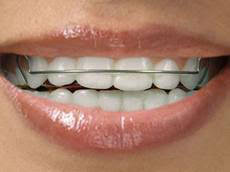 Question from Liz
Question from Liz
Hi Debra,
Thank you so much for all of the great information! I’m on the hunt for metal free and plastic/silicone/latex free braces or retainer.
I found a few silicone options but silicone doesn’t seem to work for me!
Any ideas?
Thanks so much!
Debra’s Answer
I don’t have any personal experience with braces or retainers.
Readers, any ideas?
Having said that, I just found an excellent article about materials used for retainers and braces at NOW: Is Mouth Gear Safe, Considering All That Plastic?.
They recommend asking your dentist for a retainer made of “somewhat pricier polypropylene.”
Is your objection to ALL plastic or the toxic plastics? Polypropylene is much less toxic than others.
My Almost Toxic-Free Honeymoon Weekend

The “Peace” room at the Living Light Inn in Fort Bragg, California
Over the weekend Larry and I went on a little 2-day “honeymoon” to celebrate 31 years of being together.
I’ve been getting questions about travel lately, so I thought I’d give you a real life “case study” of how we put our vacation together and what happened.
The Lodgings
When I want to go somewhere I’m always looking for a room that is as nontoxic as possible at an affordable price. For me, I expect to pay around $150/night. I’ll go a little higher for something special and I’m always happy when I can get a room for less, but I would rather pay more and be more comfortable than save money and be less comfortable.
When we were younger we would just get in the car and drive and stop wherever we wanted to stop and find a room. We had some great experiences doing that. One night—it was a Saturday night—we were in Monterey, California, where there are just no rooms on Saturday nights. We were standing in a hotel lobby, calling on a pay phone. I hung up the phone from “No Vacancy” #3 and the women at the next pay phone around poked her head around the divider and said, “Excuse me, are you looking for a room? I just had a cancellation.” We got a $500 room for $250. How could we not stay there. The room was beautiful and right on Montery Bay. We could open the window and look down at the water.
But now, with smart phones and online booking, we either book in advance, or I use hotel.com as we get close to an area. If you book last minute, you can get really good prices, but you run the risk of no rooms. One night, again, years ago, we had to drive half way across Nevada before we could get a room.
I generally start by looking for a bed and breakfast instead of a conventional hotel. They are just too toxic. Except in Fort Bragg and along Hwy 1 up the coast there, there are many, many small places to stay where the rooms are right on the cliffs overlooking the Pacific Ocean. So in that case, I would stay in a commercial hotel to get that view and that air.
We decided to spend the night in Fort Bragg on our trip. We had driven up Hwy 1 from Point Reyes, California to Victoria BC Canada on an earlier honeymoon, so this was a re-enactment of a trip we had taken before together. After living in Florida for fifteen years, I just wanted to reconnect with this land and the redwood trees and the ocean.
It took me about five minutes to find the Living Light Inn. It’s “Eco-Friendly Lodging.” That’s a photo of our room above. It’s an attic room on the third floor (no elevator). All wood paneled, with a view of the organic vegetable garden out the window. The ocean is only about four blocks away, so the air is magnificent. It’s just your average bed and carpet on the floor, but everything is so old that there are no toxic chemicals. No fragrance on the sheets from detergent, no fragrance in the bathroom from soap. We were totally comfortable.
This place has many many many glowing reviews. Most of the rooms have white walls and wood floors and are very bright an airy.
The only down side for me was that it was just a bit more funky than I like. The bathroom had a plastic shower enclosure and shelves that looked like exposed wood framing. But these were small things in comparison to the overall experience. This is not a luxury hotel. It’s good, clean rooms with clean air.
This is a vegan establishment. They have a kitchen that guests can use to prepare their own food, with a refrigerator and blenders and all the tools you might want to prepare vegan food.
They serve a vegan breakfast, which was interesting to me. I drink organic coffee with organic cream in the morning. They weren’t sure if the coffee was organic and the cream was rice milk. I was expecting plates of beautiful organic fruit. That’s vegan. But it was pretty much all packaged industrial food. But vegan.
The thing I really learned from this experience is that different people have different priorities. This establishment was “eco” and “vegan” and it expressed their understanding of those viewpoints. But they don’t have a “toxic-free” viewpoint and few places do. I need to do more work on this, to bring more awareness to lodgings about how they could really be toxic-free in addition to whatever else they are doing.
The Food
We started our trip with breakfast at the Cape Fear Cafe in Duncans Mills. I had overheard someone recommending it to a friend and wanted to try it. Very good.Since it was about 10:30 by the time we got there, Larry and I split a breakfast of veggie scrambled eggs with potatoes and toast and then we split a lunch of green salad with tandoori chicken and mango chutney on top.
Food choices is a big subject. Over the years I’ve come to having a line that I will not cross. I can’t say “I will only eat organic food” because often there isn’t any to choose. But I can usually find restaurants that serve dishes made from fresh ingredients, no additives, no cans, just real food. These places often use white refined flour and sugar and salt, but otherwise the ingredients are pretty good. That’s my line. My minimum. I won’t eat fast food or most packaged or canned food. I’ll just wait for the next meal if there is nothing else, or find some raw fruits or vegetables.
Cape Fear Cafe isn’t organic, but it could easily be as there is plenty of organic food in the area. Still, it was a very good meal.
Driving Hwy 1 the roadside services are few and far between. So when we got hungry again we stopped at the Black Point Grill in the Sea Ranch Lodge. Sea Ranch is an interesting place, worth a stop and a look around. I remember when Sea Ranch was built, starting in 1963. It was quite innovative then. The idea was to have people live in an ecosystem and preserve the natural beauty of the area. And they have accomplished and maintained that for almost fifty years now. There is no landscaping around the houses. Every house has weathered wood siding. Each house is unique. There are vacation rentals or you can stay at the Lodge. Lodge rooms start at $279/night, but it is well worth the cost. Staying here is an iconic California experience.
The food at the Black Point Grill was delicious and we were happy to see that they are vegetarian-friendly. I’m not a vegetarian but my diet is mostly plant-based, so I was happy to be able to order corn chowder and a chickpea veggie burger that was really delicious. Again not organic but they use “the freshest local ingredients.”Oh, I take that back. Some organic. The baby greens in the salad were organic.
When we reached Fort Bragg we asked the innkeeper for recommendations and she steered us to Mayan Fusion. This was a GREAT restaurant for us. It’s Mexican with a Mayan twist so the flavors were a bit different. They had a lot of nice entrees but we were able to stay on our diet by ordering salads and sides of rice and beans. Lest you think that sounds boring, we were delighted with how inventive and tasty they were. Homemade corn tortillas. And for dessert we had a Mayan chocolate ice cream with chilis, which is one of my favorite flavor combinations so we had to splurge. Larry and I rarely order dessert, but if we see something super-special, we always split it.
One of the things I love about the food in Fort Bragg is that they are very local-oriented. They really get what it meats to eat local. There are a number of local purveyors, so, for example, the Mayan chocolate ice cream was made especially for Mayan Fusion by the local ice cream maker Cowlicks. And the coffee ice cream at Cowlicks is made with a special blend from the local coffee roaster, and is unique to the ice cream. Cowlicks also has an ice cream made with a local mushroom called Candy Cap that tastes just like maple. Of course I had to try that and it really does taste like maple. Really really delicious. And the most popular breakfast spot, Eggheads, uses Canadian bacon smoked at the smokehouse down the street. You get the idea.
On Saturday morning I woke up looking for organic coffee. Since the innkeeper couldn’t guarantee their coffee was organic, he sent me down to Headland’s Coffee, his personal favorite coffee house. I walked in, wondering if it was organic. I looked at the list of “hot drinks” on the wall. It said “coffee” but not organic. And then I saw it. There was a whole rack of coffee bean dispensers and every single one said “organic.” I paid for my coffee and took my paper cup over to the double row of thermoses and every single one was organic. A dozen varieties of organic coffee! All brewed and waiting for me to try. If I lived in Fort Bragg, I would try a different one every morning.

After coffee, we tried to go to Eggheads,
but the wait was an hour. So we went down the street to the dedicated organic restaurant Cafe One. It wasn’t crowded, but the food was great. We had a Mexican breakfast of scrambled eggs on a corn tortilla with beans and rice and salsa. And a beautiful plate of assorted organic fruits, each cut carefully and arranged beautifully on the plate. The decor was unremarkable, but the food was delicious and I really appreciated their commitment to being organic through and through.
For lunch we went to Rhody’s Cafe at the Mendocino Botanical Gardens. We actually had planned to walk around the
Botanical Gardens, but it’s about a 2 hour walk and we didn’t have time. But the lunch was great. Lots of organic and local food. I had lentil soup and hummus with pita chips and dipping vegetables. Plates were decorated with edible flowers and herbs. We ate in an outdoor patio with a view o
f the gardens. Just lovely.
On the way home we stopped at a roadside stand and got the most fragrant strawberries! We at the whole basket.
The Sights
The main purpose of this honeymoon was simply to be together, enjoy each other’s company and have an adventure. We love to just go someplace and see what there is to see.
So driving up the coast we stopped at a secluded beach Larry had found and wanted to show me. It’s a public beach but it has kind of a secret entrance through a grove of redwood trees that you could easily miss if you didn’t know it was there.
We stopped at Sea Ranch and looked around.
We stopped in the town of Mendocino,
which used to be one of my favorite places of all time. Charming street of Victorian buildings on a bluff overlooking the ocean. There used to be wonderful shops there but no more. It’s all tourist shops now. I remember when Mendocino first became popular. A single restaurant opened, Cafe Beujoulais, became so outstanding that it became a destination. I remember their ads in local newspapers said simply, “Cafe Beaujolais. Mendocino. Worth the trip.” And it was. They had astonishing food for
1977. I went. And so did many others. And shops opened. And Mendocino became Mendocino. But that’s gone now.
As I get older—I’m 63 now—I’m noticing with some sadness parts of my life that used to be there and I expect to still be there are now gone. Like Mendocino. Like Thomas Bros road maps. They are no longer sold in bookstores because maps are in your phone. But last week we were out in the rural part of Sonoma county and lost reception. We needed a paper map. And I couldn’t buy one at my local bookstore. I could go to AAA and get a folding map, but Thomas Bros maps are books of maps of individual areas so you can really see them. A smart phone may be smart, but only if you have reception. A paper book you can take anywhere.
On Saturday morning we walked around the downtown area of Fort Bragg. It’s both sides of the street around one square block. It’s not for tourists. These are shops that carry the everyday items people need living far far far from the nearest mall or Walmart. And it reflects their viewpoint. Clothing is pretty much all natural fiber. There’s a cooking store with real cooking tools for the kind of cooking you do when your food comes from the farmer’s market or the forest or the ocean. A bookstore is all about connecting with nature. It’s just REAL.
And we loved it.
There’s a lot to see and do on the north coast of California. Lots of clean air. Lots of organic food. Lot’s of inns to stay in, in all price ranges. You can even bring your RV and park it in one of the RV parks that are almost right on the beach.
There’s still some summer left. Get out and explore!







